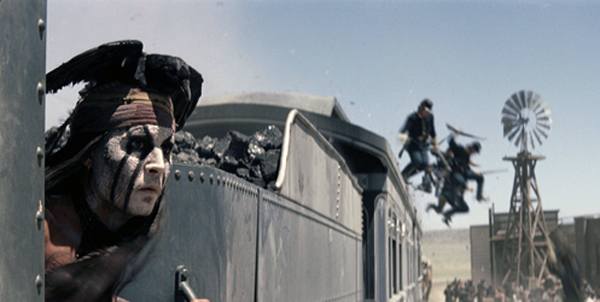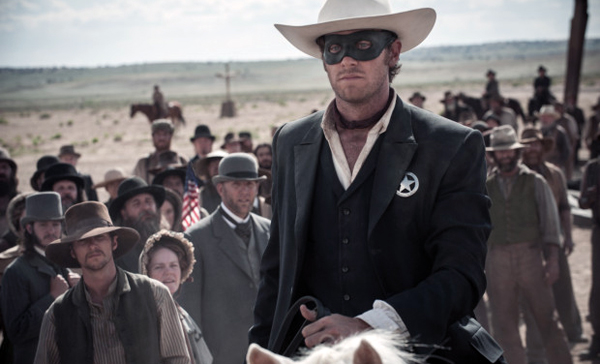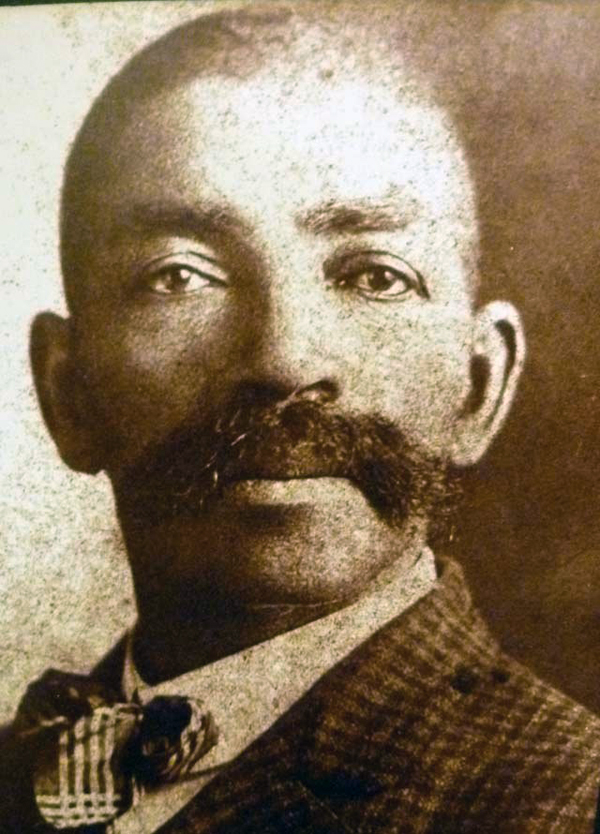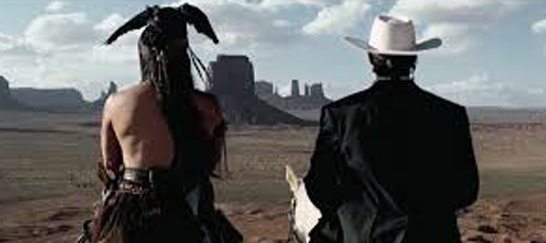By Robin Simmons
THE LONE RANGER
Bottom line: I was entertained and disappointed by the actual experience of the much-hyped “Lone Ranger” reboot.
At this writing, Disney’s gigantic summer, tent-pole, four-quadrant (both sexes, young and old), $250 million popcorn extravaganza has just opened. The “Lone Ranger” franchise, not really a familiar entity, except perhaps in name, to any but late baby boomers. The heroic and highly moral exploits of the masked Ranger and his Indian pal once permeated radio and TV. Beginning in 1933, thousands of radio episodes garnered an avid following across America when families gathered around their radios in the avening. The white Stetsoned cowboy and his trusted Comanche sidekick easily merged into hundreds more TV episodes. The Lone Ranger and Tonto are part of our mid-century American pop culture and in many ways are an iconic reminder of who we most wished to be in the world: moral and just and kind but most of all brave defenders of the weak and bullied.
Disney’s new iteration of once noble Ranger is a naïve, bumbling doofus devoid of irony or self-awareness. Armie Hammer does his best with what’s written. He’s a great casting choice. A big, sweet-faced, handsome guy. But it’s Tonto’s story that’s being told here. Depp’s chalk-faced Comanche with the dead crow headdress is a somewhat sympathetic, taciturn Buster Keaton-like character who is from “a band apart,” or just plain nuts. The two misfits are outcasts in the grand vistas of the American west. Sometimes I was reminded of Laurel and Hardy’s WAY OUT WEST. There are lots of homages (or outright steals) from other movies and directors: John Ford, Sergio Leone and even Alejandro Jodoowsky. There’s an uneven tone to the whole proceedings: at times serious, brutal, comic, period and contemporary. Same with the dialogue. Big action set pieces with real trains are enhanced with CGI to such a point that it almost numbs one’s eyeballs. However, the big replica steam engines, lovingly photographed, are a real pleasure to see screaming down the rails.
As the film unspooled – or rather downloaded from a digital file – my mind wandered. That’s not good. At times I was acutely aware the blueprint for this Gore Verbinski oater was his “Pirates of the Caribbean” franchise. Even down to the 149-minute running time and Depp in heavy make-up and Kabuki eye shadow as the understated but quirky lead. “Pirates” was a Disney ride cum movie. “Ranger” is a movie cum ride – or so it often seemed. Trying to be something for all audiences, the movie lost its identity.
In my movie loving heart, I was hoping for a gritty, dark, reimagined Ranger that was more in the mode of Christopher Nolan’s terrific Batman trilogy. I thought of Bass Reeves, the unknown historical figure “The Lone Ranger” was likely based on.
Bass was an original Badass (is “Bass” a contraction of “Badass”?). He was born a slave in 1838. He fought alongside his master in the Confederate Army. During a lull in the fighting, Reeves escaped after beating his master after being accused of cheating in a card game. He ended up in Oklahoma – then Indian Territory – and lived for a while among the Seminole and Creek tribes. He eventually married and had at least ten children. He was the first black man to work as a Deputy U.S. Marshall after U.S. Marshall James Fagan deputized him. Reeves knew the territory well and could speak several native dialects. Reeves was a master of disguises and may have arrested nearly 3,000 bad guys, killing more than a dozen. He had an Indian posse and tracker. Reeves also rode a white horse and gave out silver coins as a kind of calling card. (For more info on Reeves, look for Art Burton’s book “Black Gun, Silver Star: The Life and Legend of Frontier Marshal Bass Reeves.”)
Many of the men captured by Reeves were imprisoned in Detroit, where word of his prowess spread among prisoners and the public. And in Detroit, in 1933 on station WXYZ, the “The Lone Ranger” was first broadcast. George Trendle created it and the main writer was his brother-in-law Fran Striker.
I say all this because the possible source material is so rich, unexpected and dramatic. I kept thinking about Badass Bass Reeves as I watched the sometimes silly exploits and banter between Hammer and Depp. Why is Disney so reluctant to adhere to the core of the pop-culture hero with an unwavering moral compass? Why be so cynical? Why not embed it with a realism we crave? What a missed opportunity. I did like the subversive and not so sly references to the corporate American greed that broke treaties and spilled blood in a blind rush to fulfill a misguided sense of Manifest Destiny. Nice touches, but not nearly enough. It will be interesting to see how other critics respond to Disney’s attempt to stamp out a western franchise in the mold of “Pirates of the Caribbean” (also from producer Jerry Bruckheimer and director Verbinski). There was an earlier (1981) attempt to put “The Lone Ranger” on the big screen, but it was buried in a series of public relations fiascos. Looking back, that movie starring Klinton Spilsbury (in his only movie role) and a fine Christopher Lloyd as the villain is not so bad. I am surprised it was not released in a Blu-ray version for the home theater. (Did Disney tie up the rights?) See if you can find it. Yes, I had fun watching this second attempt to resurrect the Masked Man and Tonto, but I felt manipulated and exploited with a constant longing for what could’ve been. Not a good feeling.
The terrific cinematography and rousing Hans Zimmer score always remind you exactly how to feel. At least and at last the “William Tell Overture” was finally unleashed under the big climax. I kept waiting for that, and it worked. Nice supporting performances by Tom Wilkinson, Barry Pepper, William Fichtner and Ruth Wilson. I didn’t understand why Helena Bonham Carter was in the movie or who her character was supposed to be. Mention should be made of the horse playing Silver who had some nice moments that connected with the audience. Terrio Rossio, Tedd Elliot and Justin Haythe are given final credit for the screenplay. But from the mixed results on screen, it appears many more uncredited hands were involved. Disney is said to have spent close to $250 million on production and another $100 million on advertising. No wonder Depp’s in disguise and Hammer wears a mask.
Don’t agree? Let me know. RobinESimmons@aol.com
















































